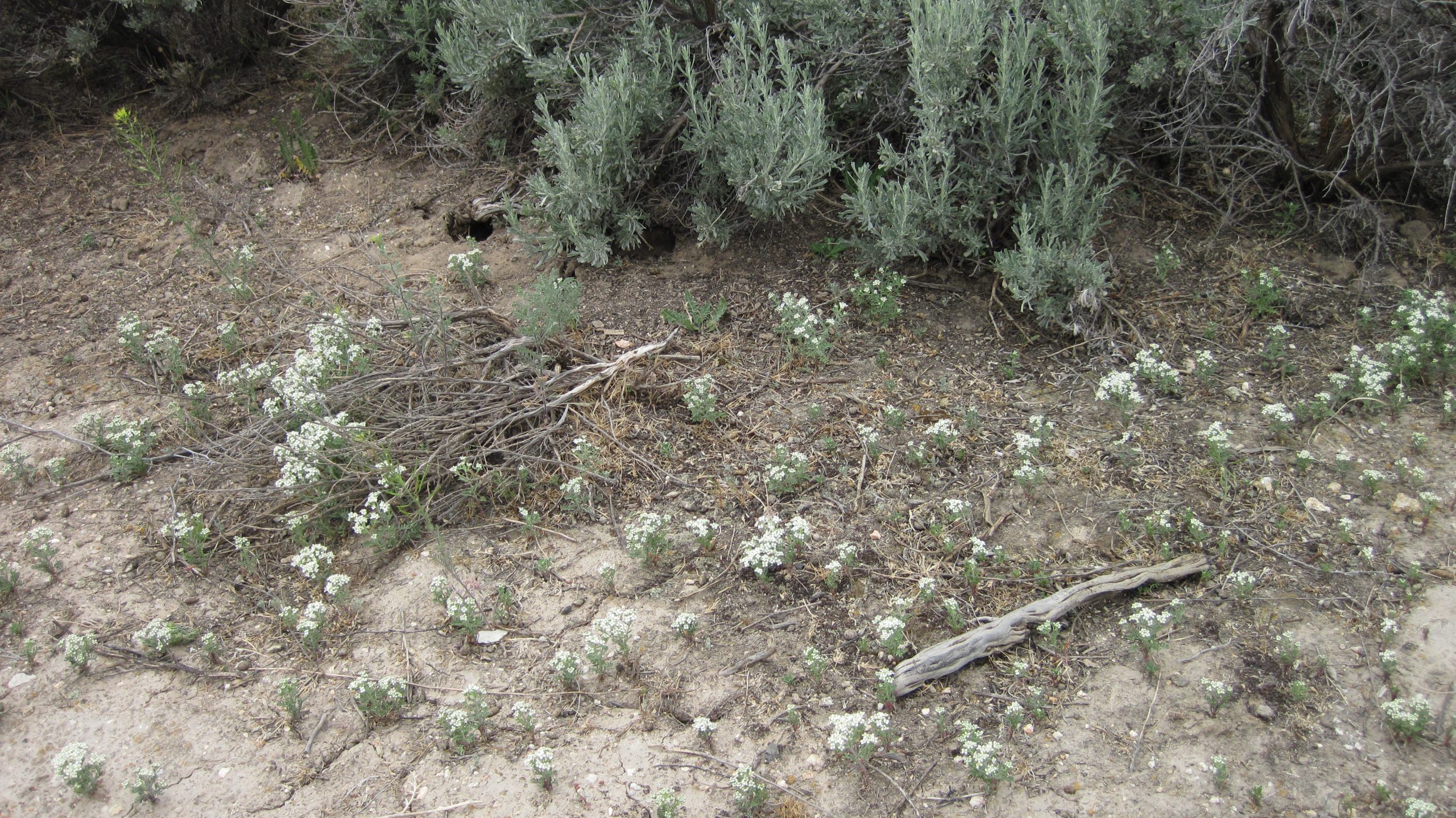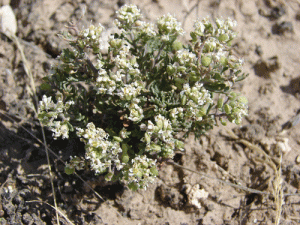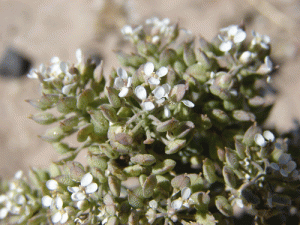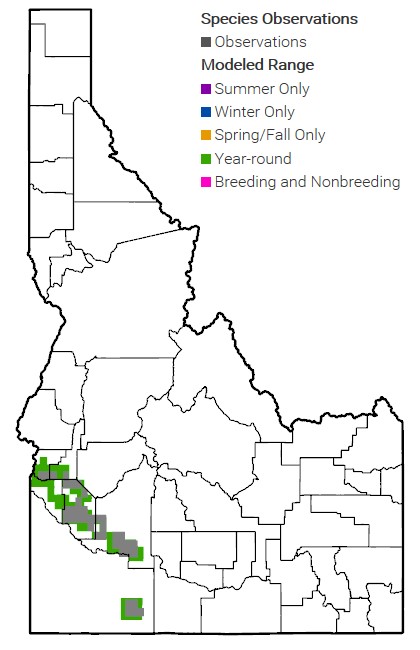ESA Status: Threatened Slickspot peppergrass (Lepidium papilliferum) is currently listed as a threatened species under the Endangered Species Act (ESA). The U.S. Fish and Wildlife Service (FWS or ‘Service’) is expected to designate critical habitat in 2022.
Slickspot peppergrass ranges from 4 to 12 inches in height, and has many small white flowers that resemble the garden flower sweet alyssum. The plant typically grows in “slickspots,” which are small areas within larger sagebrush habitat. Slickspot peppergrass is found only in southwest Idaho, including Ada, Boise, Canyon, Elmore, Gem, Owyhee, Payette, and Twin Falls counties.
Approxiamtely 87 percent of slickspot peppergrass Elemental Occurrence (EO) acreage range-wide is located on federal lands (Bureau of Land Management, U.S. Air Force, and Bureau of Reclamation). State and privately owned lands encompass 9 and 4 percent, respectively, of the EO acreage.
In October 1999, slickspot peppergrass was listed as a candidate species by the FWS. In order to conserve the plant and preclude the need for a federal listing, a number of private, state, and federal entities developed a Candidate Conservation Agreement (CCA). In January 2004, the FWS found that a listing was not warranted based on the extent of the plant’s range and abundance.
The Service listed slickspot peppergrass as a threatened species under the Endangered Species Act (ESA) in December 2009, and initially proposed designation of critical habitat in May 2011. In October 2012, the U.S. District Court for the District of Idaho vacated the Service’s 2009 listing determination and remanded it to the Service for further consideration. The court’s decision effectively suspended designation of critical habitat.
After further consideration of the court’s decision, the Service reinstated slickspot peppergrass as a threatened species in September 2016. Idaho’s comments are linked below. In April 2019, slickspot peppergrass was included in the Service’s national notice of intent to make listing decisions and designation of critical habitat for 24 species. In response to the 2019 settlement with the plaintiff, the Service published an updated proposal to designate critical habitat on July 23, 2020. Separate from this critical habitat designation, the Service developed a Species Status Assessment (SSA) for slickspot peppergrass in February 2020.
After the July 23, 2020 revised proposal was published, summarized changes were made after the public comment period that ended on September 21, 2020. Additionally, previous comments submitted during the May 10, 2011 proposed rule and February 12, 2014 revised proposed rule were considered. In May 2023, the Service published the final ruling for the designation of critical habitat for slickspot peppergrass. Approximately 78,009 acres across five counties (Ada, Elmore, Gem, Payette, and Owyhee) in Idaho fall within the boundaries set in the final critical habitat designation. Critical habitat was not designated on private or state lands and only on BLM lands. This rule is effective as of June 5, 2023.
- Department of Interior final ruling for designation of critical habitat for Lepidium papilliferum (Slickspot Peppergrass)
- Department of Interior final ruling for threatened status for Lepidium papilliferum (Slickspot Peppergrass)
- State of Idaho’s Comments; Designation of Critical Habitat for Slickspot Peppergrass
- Updated Proposal to Designate Critical Habitat
- Species Status Assessment
The SSA indicates that the primary threats to the species include: increased frequency and intensity of wildfire, the introduction and spread of invasive nonnative plants, as well as threats of residential and commercial development and associated infrastructure. Historic impacts along with these disturbances have resulted in extensive fragmentation and degradation of habitat conditions across the range of the species. Most populations are isolated such that insect facilitated genetic exchange (pollination) between populations is limited, increasing the risk of future loss of genetic diversity, particularly for small populations.
Voluntary Conservation Agreements
OSC is seeking private and municipal landowners (i.e. private, city, and county landowners) to enter into voluntary Conservation Agreements (CA) for slickspot peppergrass (Lepidium papilliferum). State and privately owned lands encompass 9 and 4 percent, respectively, of the EO acreage. OSC would like to help landowners maintain suitable habitat for the species through new or ongoing conservation efforts and best management practices to increase the potential for recovery of the species in the future. There are several best management practices that can be considered in terms of wildfire prevention, habitat restoration, rangeland health and maintaining existing slickspot peppergrass habitat. See the Memorandum of Understanding (MOU) below for more information.



Photos: Sheri Hagwood, hosted by the USDA-NRCS PLANTS Database

Map Credit: Idaho Department of Fish and Game
More Information:
Species Profile for Slickspot Peppergrass – U.S. Fish & Wildlife Service
 Official Government Website
Official Government Website